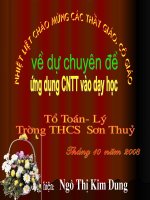Ch07 Queue.ppt
Bạn đang xem bản rút gọn của tài liệu. Xem và tải ngay bản đầy đủ của tài liệu tại đây (1.68 MB, 49 trang )
Chapter 7
Queues
Copyright © 2005 Pearson
Addison-Wesley. All rights
reserved. 7-2
Chapter Objectives
•
Examine queue processing
•
Define a queue abstract data type
•
Demonstrate how a queue can be used
to solve problems
•
Examine various queue
implementations
•
Compare queue implementations
Copyright © 2005 Pearson
Addison-Wesley. All rights
reserved. 7-3
Queues
•
A queue is a collection whose elements are
added on one end and removed from
another
•
Therefore a queue is processed in a FIFO
fashion: first in, first out
•
Elements are removed in the same order
they arrive
•
Any waiting line is a queue:
–
the check out line at a grocery store
–
the cars at a stop light
–
an assembly line
Copyright © 2005 Pearson
Addison-Wesley. All rights
reserved. 7-4
Queues
•
A queue is usually depicted horizontally
•
One end of the queue is the rear (or tail),
where elements are added
•
The other end is the front (or head), from
which elements are removed
•
Unlike a stack, which operates on one end of
the collection, a queue operates on both
ends
Copyright © 2005 Pearson
Addison-Wesley. All rights
reserved. 7-5
FIGURE 7.1
A conceptual view of a queue
Copyright © 2005 Pearson
Addison-Wesley. All rights
reserved. 7-6
Queue Operations
•
The term enqueue is used to refer to the
process of adding an element to a queue
•
Likewise, dequeue is the process of
removing an element
•
Like a stack, a pure queue does not allow
the user to access the elements in the
middle of the queue
•
We include a toString method for
convenience
Copyright © 2005 Pearson
Addison-Wesley. All rights
reserved. 7-7
FIGURE 7.2
The operations on a queue
Copyright © 2005 Pearson
Addison-Wesley. All rights
reserved. 7-8
FIGURE 7.3
The QueueADT interface in UML
Copyright © 2005 Pearson
Addison-Wesley. All rights
reserved. 7-9
Listing 7.1
Copyright © 2005 Pearson
Addison-Wesley. All rights
reserved. 7-10
Coded Messages
•
Let's use a queue to help us encode and
decode messages
•
A Ceasar cipher encodes a message by
shifting each letter in a message by a
constant amount k
•
If k is 5, A becomes F, B becomes G, etc.
•
However, this is fairly easy to break
•
An improvement can be made by changing
how much a letter is shifted depending on
where the letter is in the message
Copyright © 2005 Pearson
Addison-Wesley. All rights
reserved. 7-11
Coded Messages
•
A repeating key is a series of integers that
determine how much each character is
shifted
•
For example, consider the repeating key
3 1 7 4 2 5
•
The first character in the message is shifted
3, the next 1, the next 7, and so on
•
When the key is exhausted, we just start
over at the beginning of the key
Copyright © 2005 Pearson
Addison-Wesley. All rights
reserved. 7-12
FIGURE 7.4 An encoded message
using a repeating key
Copyright © 2005 Pearson
Addison-Wesley. All rights
reserved. 7-13
Coded Messages
•
We'll use a queue to store the values of the
key
•
We'll dequeue a value when needed
•
After using a key value, we then enqueue it
back onto the end of the queue
•
That way the queue represents the
constantly cycling values in the key
•
See Codes.java (page 183)
Copyright © 2005 Pearson
Addison-Wesley. All rights
reserved. 7-14
Listing 7.2
Copyright © 2005 Pearson
Addison-Wesley. All rights
reserved. 7-15
Listing 7.2 (cont.)
Copyright © 2005 Pearson
Addison-Wesley. All rights
reserved. 7-16
FIGURE 7.5 UML description of the
Codes program
Copyright © 2005 Pearson
Addison-Wesley. All rights
reserved. 7-17
Listing 7.3
Copyright © 2005 Pearson
Addison-Wesley. All rights
reserved. 7-18
Listing 7.3 (cont.)
Copyright © 2005 Pearson
Addison-Wesley. All rights
reserved. 7-19
Ticket Counter Simulation
•
Now let's use a queue to simulate the waiting
line at a movie theatre
•
The goal is to determine how many cashiers
are needed to keep the wait time below 7
minutes
•
We'll assume:
–
customers arrive on average every 15 seconds
–
processing a request takes two minutes once a
customer reaches a cashier
•
See Customer.java (page 186)
•
See TicketCounter.java (page 188)
Copyright © 2005 Pearson
Addison-Wesley. All rights
reserved. 7-20
Listing 7.4
Copyright © 2005 Pearson
Addison-Wesley. All rights
reserved. 7-21
Listing 7.4 (cont.)
Copyright © 2005 Pearson
Addison-Wesley. All rights
reserved. 7-22
Listing 7.4 (cont.)
Copyright © 2005 Pearson
Addison-Wesley. All rights
reserved. 7-23
FIGURE 7.6 UML description of the
TicketCounter program
Copyright © 2005 Pearson
Addison-Wesley. All rights
reserved. 7-24
FIGURE 7.7 The results of the ticket
counter simulation
Copyright © 2005 Pearson
Addison-Wesley. All rights
reserved. 7-25
Radix Sort
•
Let's look at one more use of queues
•
A radix sort uses queues to order a set of
values
•
A queue is created for each possible value in
the sort key
•
For example, if the sort key was a lowercase
alphabetic string, there would be 26 queues
•
If the sort key was a decimal integer, there
would be 10 queues corresponding to the
digits 0 through 9



![Moi gioi BAT DONG SAN 01[1].ppt](https://media.store123doc.com/images/document/12/gu/pr/medium_VqscYiF6ld.jpg)





